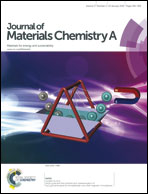High-performance CdS–ZnS core–shell nanorod array photoelectrode for photoelectrochemical hydrogen generation
Abstract
A dense array of CdS–ZnS core–shell nanorods film (1D vertically aligned) was synthesized through a simple two-step aerosol assisted chemical vapor deposition (AACVD) method. In this configuration, a ZnS nanocrystal (protective shell) was grown in situ on a CdS core, forming nanorod heterostructures to restrain the photo-corrosion and enhance the charge separation and transportation efficiencies of CdS cores. The as-prepared CdS–ZnS films showed elevated photoelectrochemical (PEC) performance (over four times than that of uncoated CdS arrays) with a significant photocurrent density of 7.8 mA cm−2 (0 V, vs. SCE) and incident photon to electron conversion efficiency (IPCE) values above 35% under AM 1.5G irradiation. Moreover, the stability of the photoelectrode was tested for over 16 min. These results suggest that the dense array of CdS–ZnS core–shell heterostructures provides a unique spatial distribution of the photo-excited charge carriers, as well as stable anti-photo-corrosion ability, and therefore is promising to be a photoelectrode in PEC hydrogen generation from water.


 Please wait while we load your content...
Please wait while we load your content...